THz Photoconductive Antenna for 800 nm Femtosecond Laser Input
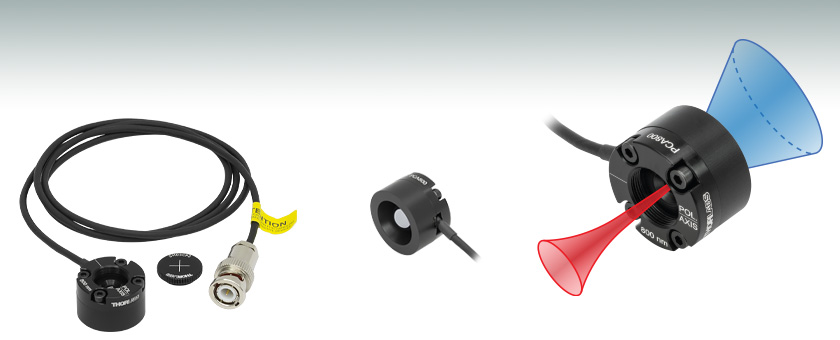
- THz Emission or Detection: 0.1 THz - 3 THz
- Femtosecond Laser Excitation with 800 nm Center Wavelength
- HRFZ-Si Collector Lens on THz Output/Input
- Low Bias Voltage: ±15 V
PCA800
THz Photoconductive Antenna for 800 nm
THz Output/Input Side Showing HRFZ-Si Collector Lens
Operation of the PCA800 Antenna as an Emitter
Focused Laser Pulse Input
THz Output

Please Wait
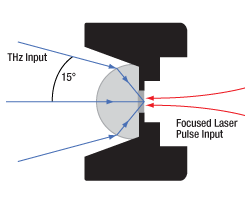
Click for Details
PCA800 Antenna Used as a THz Receiver
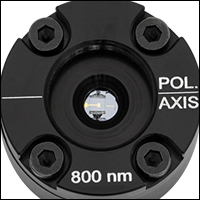
Click for Details
Optical Input Side of the PCA800 THz Photoconductive Antenna
Features
- THz Emitter or Receiver for Time-Domain Spectroscopy
- THz Emission: 0.1 THz - 3 THz
- Requires Femtosecond Laser Input Centered Around 800 nm
- Low Bias Voltage: ±15 V
- Integrated 39.0" (990 mm) Long Coaxial Cable with Male BNC Connector
The PCA800 THz Photoconductive Antenna is designed for use as either an emitter or a receiver of THz radiation in the frequency region from 0.1 - 3 THz. For both use cases, the antenna requires a focused, linearly polarized, femtosecond laser pulse input with wavelengths centered around 800 nm. The polarization of the input light needs to be aligned parallel to the engraved Polarization Axis line on the optical input side of the antenna. The optical input beam is focused by a microlens array onto the interleaving finger structure of the GaAs antenna. See the Antenna Design tab for detailed information about the antenna structure.
When the PCA800 antenna is used as a THz emitter, the microlens array allows for efficient generation of THz radiation with a low bias voltage of ±15 V. A hyper-hemispherical Si lens on the THz output side of the antenna collects and directs the THz radiation into a diverging beam with a 15° divergence angle, measured with respect to the optical axis. This beam can be collimated or re-focused using TPX THz lenses or off-axis parabolic mirrors. Please see the Specs tab for full specifications on the required optical input as well as the expected THz output.
For use of the PCA800 antenna as a receiver, both the femtosecond laser and THz inputs are necessary. The diagram at the top right of this tab illustrates the operation of the antenna as a receiver. The THz input NA should be less than 0.26 (corresponding to a 15° half angle with respect to the optical axis) for efficient collection by the hyper-hemispherical Si lens. When the two pulses coincide at the receiver, a small signal will be detected through the attached cable. This electrical signal will be low, so a lock-in amplifier and signal averaging are recommended.
The antenna can be used as THz emitter or receiver in pulsed-laser, gated, broadband THz measurement systems for time-domain spectroscopy or as a photomixing emitter or receiver in tunable, continuous-wave THz measurement systems. The Graphs tab presents performance data for a pair of PCA800 antennas, one used as the emitter and a second used as a receiver. The Application tab provides more information on how one could use a pair of these antennas in a system for time-domain spectroscopy.
Mounting Options
For easy integration into a 30 mm cage system combined with the ability to rotate the antenna into alignment with the incoming linearly polarized optical pulse, the PCA800 antenna can be mounted in a CRM1LT Cage Rotation Mount. Additionally, the PCA800 antenna has internal SM05 (0.535"-40) threads on the optical input side of the antenna, which can hold the included SM05CP2 End Cap to keep the antenna protected or can be used with Thorlabs’ Ø1/2" lens tubes for integrating optical components directly onto the optical input of the antenna.
| Hyperhemisperical Lens Specificationsa | |
|---|---|
| Material | Undoped High Resistivity Float Zone Silicon (HRFZ-Si) |
| Specific Resistance | >10 kΩcm |
| Refractive Index | 3.41 |
| Diameter | 12 mm |
| Height | 7.1 mm |
| PCA800 General Specifications | |
|---|---|
| THz Beam Divergence | 15° |
| THz Beam Virtual Focal Lengtha | 27.9 mm |
| THz Output Powerb | <7 μW |
| Max Bias Voltage | ±15 V |
| Bias Modulation Frequency | 0 - 10 MHz |
| Excitation Laser Center Wavelengthc | 800 nm |
| Excitation Laser Polarization | Linear |
| Average Laser Power (P)d | <500 mW |
| Average Laser Intensityd,e | <620 W/cm2 |
| Laser Fluenced | <6 µJ/cm2 |
| Laser Beam Diameter (2*w0)f | 100 - 300 µm |
| Laser Pulse Durationg | <100 fs |
| Dark Resistance, Rdh | >40 kΩ |
| Bias/Output Connector | BNC |
| Cable Length | 1 m |
| Storage Temperature | -10 °C - 65 °C |
| Package Dimensions | Ø1" x 0.6" (Ø25.4 mm x 15.8 mm) |
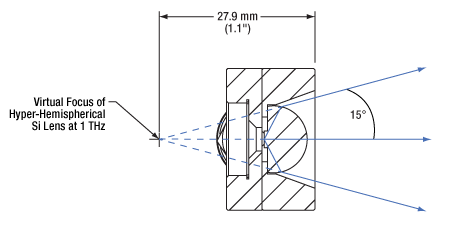
Click to Enlarge
Cross Section View of PCA800 Showing Virtual Focus Definition
| Photoconductive Antenna Specifications | |
|---|---|
| Substrate Material | Semi-Insulating GaAs |
| Chip Area | 4 mm x 4 mm |
| Thickness | 650 μm |
| Active Area | 300 μm x 300 μm |
| Dipole Length | 21 μm |
| Gap Distance | 5 μm |
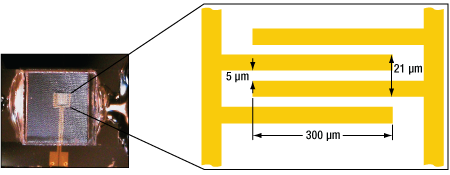
Click to Enlarge
The PCA800 Antenna has a microlens array with an efficient fill factor to focus most of the input optical beam into every other gap in the many interleaving electrodes of the antenna. A photograph of the active area of the antenna, seen through the microlens array, is shown at left, with a diagram of the fine structure of the antenna shown at right. Please note that this diagram is not to scale, as indicated by the measurements.
Performance graphs for a pair of PCA800 antennas are shown below. The antenna pair was tested with both a Ti:sapphire laser and a frequency-doubled FSL1550 Femtosecond Fiber Laser. A short description of how the THz electric field and spectrum data was acquired is given below, and more details on a typical system like this are provided in the THz Application tab.
For both lasers, the femtosecond IR pulse was used as the input to a PCA800 antenna, generating a THz output pulse, which was then collected and directed toward a second PCA800 antenna for detection. The experimental details of the input pulses are listed in the captions below.
A small portion (~10%) of the femtosecond pulse used to generate the THz radiation was directed toward the receiver antenna. This femtosecond pulse was scanned in time across the PCA800 receiver antenna through the use of a variable delay path. When both the femtosecond pulse and the THz radiation were incident simultaneously on the receiver antenna, a signal was generated and collected through the BNC cable on the PCA800 receiver antenna. The femtosecond optical pulses are significantly shorter than the THz pulse, so by scanning the femtosecond pulse in time, the THz electric field can be directly sampled as a function of time, with a resolution of the femtosecond pulse width. The results of these scans are shown in the THz Electric Field graphs below. This field was then Fourier transformed to obtain the spectrum of the THz pulse generated in the emitter antenna.
An Excel file with the raw data for the THz electric field and spectrum data presented below is available for download.
For the data presented above, the input to the PCA800 Antenna had an average power of 300 mW with a 250 µm 1/e2 beam diameter from a Ti:sapphire laser. The spectrum was centered at 780 nm and partially dispersion compensated, resulting in a 20 fs pulse duration. The antenna had a 15 V DC bias applied through the BNC connector, and the signal modulation frequency was 4 kHz. The blue shaded region of the THz Spectrum graph indicates the range of frequencies over which the PCA800 antenna is recommended for use. Raw data for the above graphs can be downloaded by clicking here.
For the data presented above, the input to the PCA800 Antenna was the second harmonic generation of an FSL1550 Femtosecond Fiber Laser. The frequency-doubled output was centered at 775 nm, dispersion compensated to a 24 fs pulse duration, and had an average power of 50 mW and a 250 µm 1/e2 beam diameter. The antenna had a 15 V DC bias applied through the BNC connector, and the signal modulation frequency was 4 kHz. The blue shaded region of the THz Spectrum graph indicates the range of frequencies over which the PCA800 antenna is recommended for use. Raw data for the above graphs can be downloaded by clicking here.
THz Time-Domain Spectroscopy System Overview
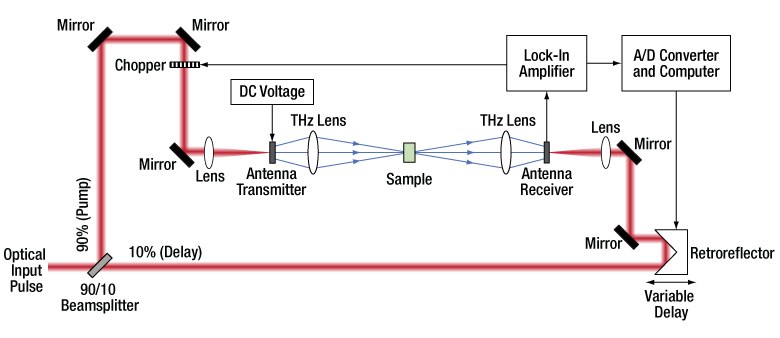
The diagram above shows an example time-domain spectroscopy system that could be built using a pair of PCA800 antennas.
Time-domain spectroscopy (TDS) using THz radiation allows for measurements of both the amplitude and the phase of the interrogating radiation, unlike spectroscopy with optical fields, where only the intensity of the field can be directly measured. A wide range of materials, including metals and gases, can be measured using this technique. The THz radiation used in these systems can be both generated and detected by a pair of PCA800 Photoconductive Antennas, allowing for spectroscopic measurements in the range of 0.1 - 3 THz. The system above gives an example of the types of components used and the basic optical layout of a THz TDS system that could be built using a pair of PCA800 THz antennas. For a detailed tutorial on THz TDS, please see Neu and Schmuttenmaer's "Tutorial: An introduction to terahertz time domain spectroscopy (THz-TDS)."1

Click to Enlarge
The frequency-doubled output of the FSL1550 Femtosecond Fiber Laser can be used as the pulse source for the PCA800 antenna.
THz Radiation Generation
The main input to the THz TDS system, shown at the bottom left of the diagram above, is a femtosecond laser pulse centered around 800 nm. This pulse could come directly from a source, or by frequency-doubling the output of the FSL1550 Femtosecond Fiber Laser using an NLC07 β-BBO crystal. Both lasers have been used in a system like this to provide performance data for a pair of PCA800 antennas.
In the system shown above, the optical input pulse is split into two beams, with the majority (90%) of the light going into generating the THz radiation (labeled the Pump beam in the image above). Because the signal at the receiver antenna will be small, and a lock-in amplifier is recommended, the THz emission signal should be modulated. This can be done either through the use of an optical chopper in the Pump beam, or through modulation of the of the bias voltage on the antenna. The system above uses an optical chopper to modulate the input optical pulse, which will in turn result in a modulated THz emission from the antenna.
The Pump beam is then directed normal to the optical input surface of the antenna and focused down to the active area of the antenna for efficient THz generation. Note that the laser polarization needs to be aligned parallel to the Pol. Axis marking on the input side of the PCA800 antenna. Be careful not to exceed recommended fluence levels (J/cm2) on the antenna.
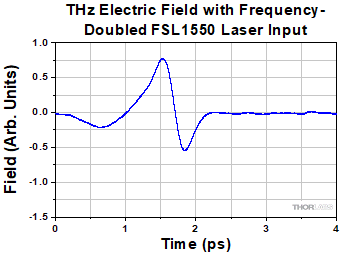
Click to Enlarge
Click Here for Data
This graph shows the THz electric field measured using a frequency-doubled FSL1550 Femtosecond Fiber Laser input and two
PCA800 antennas.
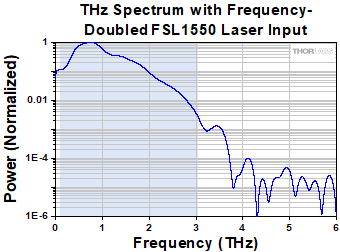
Click to Enlarge
Click Here for Data
This graph shows the Fourier Transform of the THz electric field. The blue shaded region of the THz Spectrum graph indicates the range of frequencies over which the PCA800 antenna is recommended for use.
Up to the saturation level of the antenna, more optical power into the antenna will result in more THz power out. The THz output spectrum also depends on the optical input characteristics. For example, the dispersion compensation of the input pulse has been shown to affect both the efficiency of THz generation and the spectral profile of the THz output.2 A shorter, transform-limited input pulse will result in THz output radiation with broader spectral content than that resulting from a longer, chirped input pulse, because the temporally delayed frequency components of the chirped pulse lead to destructive interference of the THz radiation and affect its spectral profile.
In addition to the input optical pulse, a voltage is applied across the PCA800 antenna through the integrated coaxial cable. For the system above, a DC voltage is applied to the antenna. A larger applied voltage, within the recommended limits, will result in more THz power emitted from the antenna. Alternatively, if an optical chopper is not used, a modulated voltage can be applied to the antenna to modulate the THz output.
The THz output from the emitter antenna has a divergence angle of 15° relative to the optical axis, which can be collected and collimated or focused using either THz lenses or off-axis parabolic mirrors. Once the radiation has traversed the sample under test, the same types of lenses or mirrors can be used to send the light into the THz receiver antenna. 1:1 imaging from the emitter antenna output to the receiver antenna input is recommended. The THz input beam will be collected by the hyper-hemispherical Si lens on the THz input side of the receiver antenna.
Optical Delay Line and Detection of THz Signal
Both the THz input and the femtosecond laser input pulse are required for detection at the receiver antenna. As shown in the figure above, 10% of the pulse used to generate the THz radiation at the emitter antenna is split off for use with the receiver antenna. This is labeled the Delay beam in the figure above.
For a given optical pulse, the paths are set so the Delay portion of that pulse arrives at the receiver antenna simultaneously with the THz pulse generated by the Pump portion of the optical pulse. In setting this Delay path, be sure to consider the full optical path from the 90/10 beamsplitter to the PCA800 receiver antenna. This includes the HRFZ-Si lenses integrated into the PCA800 antennas, which are 7.1 mm thick with an index of refraction of ~3.41, as well as any additional optical components in the THz portion of the optical train. At the receiver antenna, align the input laser beam onto the active area of the detector antenna using the same conditions as the emitter arm, except the intensity can be much lower, ~10% of that used at the emitter antenna.
The femtosecond optical pulse is significantly shorter in duration than the THz pulse. Therefore, they only overlap in time at the antenna for a short time, given by the optical pulse width. In order to sample the entire THz pulse, the optical pulse delay is scanned, for example through the use of retroreflector mirror mounted on a motorized stage (such as one driven by a stepper, DC servo, or voice coil). Thorlabs also offers integrated solutions for a variable delay of up to 4000 ps through the optical delay line systems.
The signal level on the receiver antenna output BNC cable will be low, so a lock-in amplifier and averaging are recommended. The signal to the optical chopper, or the modulation signal to the emitter antenna, is used for triggering the lock-in amplifier.
An example of THz field data is presented in the graph on the top right. For this experiment, the input to the PCA800 Antenna was the second harmonic generation of an FSL1550 Femtosecond Fiber Laser. The optical input spectrum was centered at 775 nm and dispersion compensated, resulting in a 24 fs pulse duration. The antenna had a 15 V DC bias applied through the BNC connector, and the signal modulation frequency was 4 kHz, driving an optical chopper in the input laser beam. A pair of MPD229-M03 off-axis parabolic mirrors were used to collimate the THz radiation from the PCA800 antenna remitter and refocus it onto the PCA800 antenna receiver. By taking the Fourier Transform of the electric field, the spectrum of the THz radiation can be calculated, as shown in the graph to the right.
This system can be used for time-domain spectroscopy experiments. The optical path length of a sample can be measured by measuring its effect on the electric field signal. Any additional path length inserted into the THz radiation beam path would result in a shift of the electric field signal in time. The spectral properties in the THz regime may also be measured by comparing the THz spectrum with and without a sample inserted into the beam path.
References
- J. Neu and C. A. Schmuttenmaer, "Tutorial: An introduction to terahertz time domain spectroscopy (THz-TDS)," Journal of Applied Physics 124.23 (2018) p. 231101.
- J. Hamazaki, K. Furusawa, N. Sekine, A. Kasamatsu, and I. Hosako, "Effects of chirp of pump pulses on broadband terahertz pulse spectra generated by optical rectification," Japanese Journal of Applied Physics 55.11 (2016) p. 110305.
| Posted Comments: | |
L Guo
(posted 2024-10-28 19:49:47.827) As for PCA800, what are the specific requirements for the laser source of it? For example, can a 200fs, 800KHz, power enough light source excite PCA800? What is the impact on PCA800‘s performance? |
 Products Home
Products Home








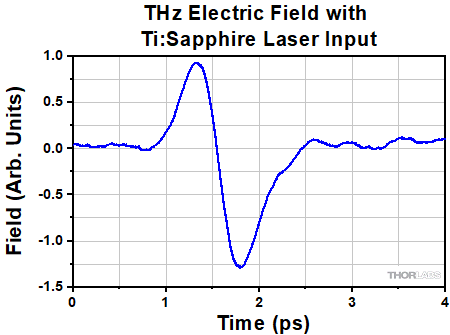
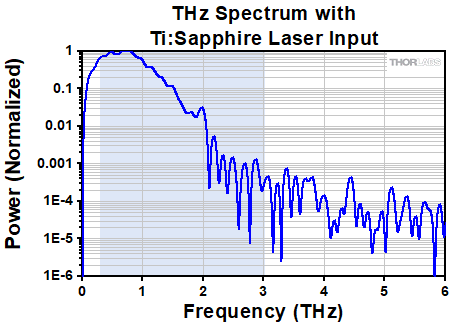
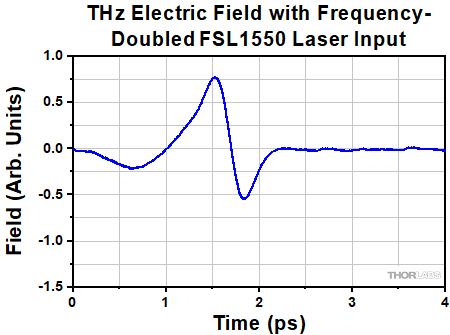
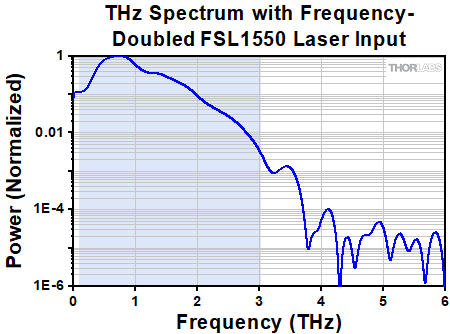

 800 nm Input THz Antenna
800 nm Input THz Antenna